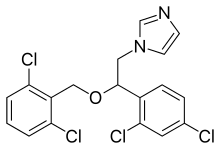Isoconazole
Isoconazole is an azole antifungal drug and could inhibit gram positive bacteria.[1][2] For foot and vaginal infections, isoconazole has a similar effectiveness to clotrimazole.[3][4] Isoconazole nitrate may be used in combination with corticosteroid diflucortolone to increase its bioavailability.[1]
 | |
| Clinical data | |
|---|---|
| AHFS/Drugs.com | International Drug Names |
| ATC code | |
| Identifiers | |
IUPAC name
| |
| CAS Number | |
| PubChem CID | |
| DrugBank | |
| ChemSpider | |
| UNII | |
| KEGG | |
| ChEBI | |
| ChEMBL | |
| CompTox Dashboard (EPA) | |
| ECHA InfoCard | 100.044.084 |
| Chemical and physical data | |
| Formula | C18H14Cl4N2O |
| Molar mass | 416.127 g/mol g·mol−1 |
| 3D model (JSmol) | |
SMILES
| |
It was patented in 1968 and approved for medical use in 1979.[5]
References
- Veraldi, Stefano (May 2013). "Isoconazole nitrate: a unique broad-spectrum antimicrobial azole effective in the treatment of dermatomycoses, both as monotherapy and in combination with corticosteroids". Mycoses. 56 Suppl 1: 3–15. doi:10.1111/myc.12054. ISSN 1439-0507. PMID 23574019.
- The Merck Index, 12th Edition, 5176
- Oyeka, C.A.; Gugnani H.C. (1992). "Isoconazole nitrate versus clotrimazole in foot and nail infections due to Hendersonula toruloidea, Scytalidium hyalinum and dermatophytes". Mycoses. 35 (11–12): 357–61. doi:10.1111/j.1439-0507.1992.tb00894.x. PMID 1302811.
- Cohen, L. (1984). "Single dose treatment of vaginal candidosis: comparison of clotrimazole and isoconazole". Retrieved 2008-05-23.
- Fischer, Jnos; Ganellin, C. Robin (2006). Analogue-based Drug Discovery. John Wiley & Sons. p. 502. ISBN 9783527607495.
This article is issued from
Wikipedia.
The text is licensed under Creative
Commons - Attribution - Sharealike.
Additional terms may apply for the media files.